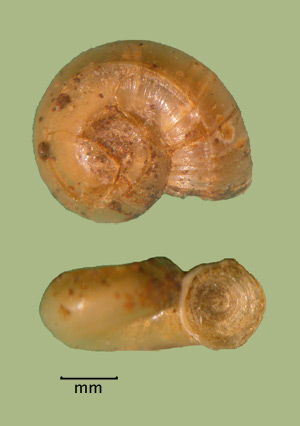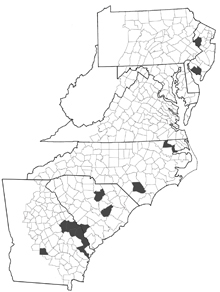> Habitat & Distribution
Valvata bicarinata has been reported from rivers and lakes in scattered eastern and midwestern North American states, including Illinois, Iowa, New Jersey, Pennsylvania, Tennessee, Alabama, Georgia, and North Carolina (Walker 1906, Burch 1989, Stewart 2006). We have documented two populations in Georgia, one population in South Carolina's Lake Marion, and one population in the northeast corner of North Carolina, at Wiccacon Creek. We were also rather surprised to discover an apparently large population at a depth of about 2 feet in New Jersey's Union Lake, in a bed of emergent vegetation. FWGNA incidence rank I-3*, non-apparently rare.
> Ecology & Life History
Valvatids are typical elements of the fauna of northern latitudes, especially cooler, well-oxygenated lakes. Valvata bicarinata is at least somewhat sensitive to environmental degradation; this species became extinct in Oneida Lake, New York State, following some years of artificial eutrophication (Harman 2000). We were therefore gratified by the 2009 discovery of a V. bicarinata population at a depth of 3.2 m in the highly disturbed Lake Marion impoundment. This makes us wonder additional populations of this otherwise rare gastropod might be present in other poorly-sampled impoundments throughout the south.
Valvata bicarinata is monecious (Clarke 1981, Brown 2001). The spherical egg capsules contain 1-60 eggs, and developing embryos are green (Clarke 1981).
The ciliated body and mantle extension demonstrated by V. piscinalis led Tsikhon-Likanina (1961) to suggest that valvatids may be filter-feeders, although this is by no means certain (Fretter & Graham 1962).
> Taxonomy & Systematics
Valvata species are notoriously polymorphic, and Valvata bicarinata is no exception (Walker 1906, Burch 1989). A single population can reportedly contain multiple morphological variants (Burch 1989). Whereas typical V. bicarinata demonstrate two spiral carinae or angulations on the shell, a morph (variety normalis) with three carinae also exists (Burch 1989). To complicate the situation further, populations of V. tricarinata occasionally contain individuals with bicarinate shells. The systematics of the North American Valvatidae are a mess.
> Maps and Supplementary Resources
- Valvata distribution in Atlantic drainages (2023)
- Valvata distribution in Georgia and the Florida panhandle (2025)
> Essays
- I mentioned the Wiccacon Creek population of Valvata bicarinata in my essay of 17Nov05 on the Aerial Dispersal of Freshwater Gastropods.
> References
Brown, K.M. 2001. Mollusca: Gastropoda. In: J.H. Thorp and A.P. Covich, eds., Ecology and Classification of North American Freshwater Invertebrates, Academic Press, New York. Pp. 297-329.
Burch, J.B. 1989. North American Freshwater Snails. Malacological Publications, Hamburg, Michigan.
Clarke, A.H. 1981. The Freshwater Molluscs of Canada. National Museum of Natural Sciences, National Museums of Canada, Ottawa, Canada.
Fretter, V. & Graham, A. 1962. British Prosobranch Molluscs. Ray Society, London.
Harman, W.N. 2000. Diminishing species richness of mollusks in Oneida Lake, New York State, USA. Nautilus 114:120-126.
Heard, W. H. 1963. Reproductive features of Valvata. The Nautilus 77:64-68.
Stewart, T.W. 2006. The freshwater gastropods of Iowa (1821-1998): species composition, geographic distributions, and conservation concerns. Amer. Malac. Bull. 21: 59 75.
Tsikhon-Likanina, E.A. 1961. On the filtration method of feeding in Bithynia tentaculata (L) and Valvata piscinalis (Muller). Byvlleten Instituta Biologii Vodokhranilishch 10: 28 - 30.
Walker, B. 1906. Notes on Valvata. Nautilus 20:25-32.









